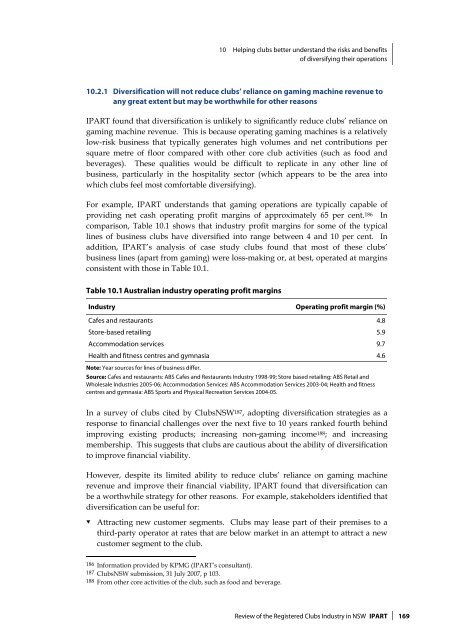Review of the Registered Clubs Industry in NSW - Clubs NSW
Review of the Registered Clubs Industry in NSW - Clubs NSW
Review of the Registered Clubs Industry in NSW - Clubs NSW
Create successful ePaper yourself
Turn your PDF publications into a flip-book with our unique Google optimized e-Paper software.
10 Help<strong>in</strong>g clubs better understand <strong>the</strong> risks and benefits<br />
<strong>of</strong> diversify<strong>in</strong>g <strong>the</strong>ir operations<br />
10.2.1 Diversification will not reduce clubs’ reliance on gam<strong>in</strong>g mach<strong>in</strong>e revenue to<br />
any great extent but may be worthwhile for o<strong>the</strong>r reasons<br />
IPART found that diversification is unlikely to significantly reduce clubs’ reliance on<br />
gam<strong>in</strong>g mach<strong>in</strong>e revenue. This is because operat<strong>in</strong>g gam<strong>in</strong>g mach<strong>in</strong>es is a relatively<br />
low-risk bus<strong>in</strong>ess that typically generates high volumes and net contributions per<br />
square metre <strong>of</strong> floor compared with o<strong>the</strong>r core club activities (such as food and<br />
beverages). These qualities would be difficult to replicate <strong>in</strong> any o<strong>the</strong>r l<strong>in</strong>e <strong>of</strong><br />
bus<strong>in</strong>ess, particularly <strong>in</strong> <strong>the</strong> hospitality sector (which appears to be <strong>the</strong> area <strong>in</strong>to<br />
which clubs feel most comfortable diversify<strong>in</strong>g).<br />
For example, IPART understands that gam<strong>in</strong>g operations are typically capable <strong>of</strong><br />
provid<strong>in</strong>g net cash operat<strong>in</strong>g pr<strong>of</strong>it marg<strong>in</strong>s <strong>of</strong> approximately 65 per cent. 186 In<br />
comparison, Table 10.1 shows that <strong>in</strong>dustry pr<strong>of</strong>it marg<strong>in</strong>s for some <strong>of</strong> <strong>the</strong> typical<br />
l<strong>in</strong>es <strong>of</strong> bus<strong>in</strong>ess clubs have diversified <strong>in</strong>to range between 4 and 10 per cent. In<br />
addition, IPART’s analysis <strong>of</strong> case study clubs found that most <strong>of</strong> <strong>the</strong>se clubs’<br />
bus<strong>in</strong>ess l<strong>in</strong>es (apart from gam<strong>in</strong>g) were loss-mak<strong>in</strong>g or, at best, operated at marg<strong>in</strong>s<br />
consistent with those <strong>in</strong> Table 10.1.<br />
Table 10.1 Australian <strong>in</strong>dustry operat<strong>in</strong>g pr<strong>of</strong>it marg<strong>in</strong>s<br />
<strong>Industry</strong> Operat<strong>in</strong>g pr<strong>of</strong>it marg<strong>in</strong> (%)<br />
Cafes and restaurants 4.8<br />
Store-based retail<strong>in</strong>g 5.9<br />
Accommodation services 9.7<br />
Health and fitness centres and gymnasia 4.6<br />
Note: Year sources for l<strong>in</strong>es <strong>of</strong> bus<strong>in</strong>ess differ.<br />
Source: Cafes and restaurants: ABS Cafes and Restaurants <strong>Industry</strong> 1998-99; Store based retail<strong>in</strong>g: ABS Retail and<br />
Wholesale Industries 2005-06; Accommodation Services: ABS Accommodation Services 2003-04; Health and fitness<br />
centres and gymnasia: ABS Sports and Physical Recreation Services 2004-05.<br />
In a survey <strong>of</strong> clubs cited by <strong>Clubs</strong><strong>NSW</strong> 187 , adopt<strong>in</strong>g diversification strategies as a<br />
response to f<strong>in</strong>ancial challenges over <strong>the</strong> next five to 10 years ranked fourth beh<strong>in</strong>d<br />
improv<strong>in</strong>g exist<strong>in</strong>g products; <strong>in</strong>creas<strong>in</strong>g non-gam<strong>in</strong>g <strong>in</strong>come 188 ; and <strong>in</strong>creas<strong>in</strong>g<br />
membership. This suggests that clubs are cautious about <strong>the</strong> ability <strong>of</strong> diversification<br />
to improve f<strong>in</strong>ancial viability.<br />
However, despite its limited ability to reduce clubs’ reliance on gam<strong>in</strong>g mach<strong>in</strong>e<br />
revenue and improve <strong>the</strong>ir f<strong>in</strong>ancial viability, IPART found that diversification can<br />
be a worthwhile strategy for o<strong>the</strong>r reasons. For example, stakeholders identified that<br />
diversification can be useful for:<br />
<br />
Attract<strong>in</strong>g new customer segments. <strong>Clubs</strong> may lease part <strong>of</strong> <strong>the</strong>ir premises to a<br />
third-party operator at rates that are below market <strong>in</strong> an attempt to attract a new<br />
customer segment to <strong>the</strong> club.<br />
186 Information provided by KPMG (IPART’s consultant).<br />
187 <strong>Clubs</strong><strong>NSW</strong> submission, 31 July 2007, p 103.<br />
188 From o<strong>the</strong>r core activities <strong>of</strong> <strong>the</strong> club, such as food and beverage.<br />
<strong>Review</strong> <strong>of</strong> <strong>the</strong> <strong>Registered</strong> <strong>Clubs</strong> <strong>Industry</strong> <strong>in</strong> <strong>NSW</strong> IPART 169
















